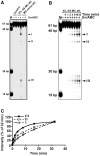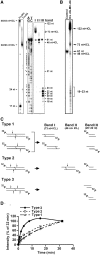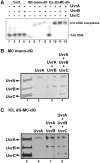Repair of mitomycin C mono- and interstrand cross-linked DNA adducts by UvrABC: a new model
- PMID: 20647419
- PMCID: PMC2978355
- DOI: 10.1093/nar/gkq576
Repair of mitomycin C mono- and interstrand cross-linked DNA adducts by UvrABC: a new model
Abstract
Mitomycin C induces both MC-mono-dG and cross-linked dG-adducts in vivo. Interstrand cross-linked (ICL) dG-MC-dG-DNA adducts can prevent strand separation. In Escherichia coli cells, UvrABC repairs ICL lesions that cause DNA bending. The mechanisms and consequences of NER of ICL dG-MC-dG lesions that do not induce DNA bending remain unclear. Using DNA fragments containing a MC-mono-dG or an ICL dG-MC-dG adduct, we found (i) UvrABC incises only at the strand containing MC-mono-dG adducts; (ii) UvrABC makes three types of incisions on an ICL dG-MC-dG adduct: type 1, a single 5' incision on 1 strand and a 3' incision on the other; type 2, dual incisions on 1 strand and a single incision on the other; and type 3, dual incisions on both strands; and (iii) the cutting kinetics of type 3 is significantly faster than type 1 and type 2, and all of 3 types of cutting result in producing DSB. We found that UvrA, UvrA+UvrB and UvrA+UvrB+UvrC bind to MC-modified DNA specifically, and we did not detect any UvrB- and UvrB+UvrC-DNA complexes. Our findings challenge the current UvrABC incision model. We propose that DSBs resulted from NER of ICL dG-MC-dG adducts contribute to MC antitumor activity and mutations.
Figures





Similar articles
-
Differential incision of bulky carcinogen-DNA adducts by the UvrABC nuclease: comparison of incision rates and the interactions of Uvr subunits with lesions of different structures.Biochemistry. 2000 Oct 10;39(40):12252-61. doi: 10.1021/bi0013187. Biochemistry. 2000. PMID: 11015204
-
Robust incision of Benoz[a]pyrene-7,8-dihyrodiol-9,10-epoxide-DNA adducts by a recombinant thermoresistant interspecies combination UvrABC endonuclease system.Biochemistry. 2006 Jun 27;45(25):7834-43. doi: 10.1021/bi052515e. Biochemistry. 2006. PMID: 16784235 Free PMC article.
-
Recognition and incision of gamma-radiation-induced cross-linked guanine-thymine tandem lesion G[8,5-Me]T by UvrABC nuclease.Chem Res Toxicol. 2005 Sep;18(9):1339-46. doi: 10.1021/tx050147+. Chem Res Toxicol. 2005. PMID: 16167825 Free PMC article.
-
Structure and function of the (A)BC excinuclease of Escherichia coli.Mutat Res. 1990 Sep-Nov;236(2-3):203-11. doi: 10.1016/0921-8777(90)90005-p. Mutat Res. 1990. PMID: 2204825 Review.
-
New insights on how nucleotide excision repair could remove DNA adducts induced by chemotherapeutic agents and psoralens plus UV-A (PUVA) in Escherichia coli cells.Mutat Res. 2003 Nov;544(2-3):143-57. doi: 10.1016/j.mrrev.2003.06.003. Mutat Res. 2003. PMID: 14644316 Review.
Cited by
-
Synthesis of Oligonucleotides Containing Trans Mitomycin C DNA Adducts at N6 of Adenine and N2 of Guanine.Chemistry. 2021 Oct 13;27(57):14263-14272. doi: 10.1002/chem.202102338. Epub 2021 Sep 8. Chemistry. 2021. PMID: 34319608 Free PMC article.
-
Antitumor Activity of a Novel Double-Targeted System for Folate Receptor-Mediated Delivery of Mitomycin C.ACS Omega. 2020 Oct 6;5(41):26864-26870. doi: 10.1021/acsomega.0c04042. eCollection 2020 Oct 20. ACS Omega. 2020. PMID: 33111012 Free PMC article.
-
Mitomycin C as an Anti-Persister Strategy against Klebsiella pneumoniae: Toxicity and Synergy Studies.Antibiotics (Basel). 2024 Aug 28;13(9):815. doi: 10.3390/antibiotics13090815. Antibiotics (Basel). 2024. PMID: 39334989 Free PMC article.
-
Abasic and oxidized abasic site reactivity in DNA: enzyme inhibition, cross-linking, and nucleosome catalyzed reactions.Acc Chem Res. 2014 Feb 18;47(2):646-55. doi: 10.1021/ar400229d. Epub 2013 Dec 26. Acc Chem Res. 2014. PMID: 24369694 Free PMC article.
-
Nucleotide excision repair of chemically stabilized analogues of DNA interstrand cross-links produced from oxidized abasic sites.Biochemistry. 2014 Sep 23;53(37):5958-65. doi: 10.1021/bi500914d. Epub 2014 Sep 10. Biochemistry. 2014. PMID: 25208227 Free PMC article.
References
-
- Kusenda Z, Kerger J, Awada A, Geurs F, Van Vreckem A, Habboubi N, Piccart MJ. Mitomycin C and vinblastine in combination with amifostine in metastatic breast cancer. A feasibility study of the EORTC–Investigational Drug Branch for Breast Cancer (IDBBC) Support Care Cancer. 1997;5:414–416. - PubMed
-
- Lenaz L. Mitomycin C in advanced breast cancer. Cancer Treat. Rev. 1985;12:235–249. - PubMed
-
- Bolenz C, Cao Y, Arancibia MF, Trojan L, Alken P, Michel MS. Intravesical mitomycin C for superficial transitional cell carcinoma. Expert Rev. Anticancer Ther. 2006;6:1273–1282. - PubMed
-
- Snegovoy A, Manzuk L, Artamonova E. Mitomycin plus capecitabine in metastatic breast cancer. 2008 Breast Cancer Symposium. 2008 General Poster Session E, Abstract No: 264.
-
- Bizanek R, McGuinness BF, Nakanishi K, Tomasz M. Isolation and structure of an intrastrand cross-link adduct of mitomycin C and DNA. Biochemistry. 1992;31:3084–3091. - PubMed

